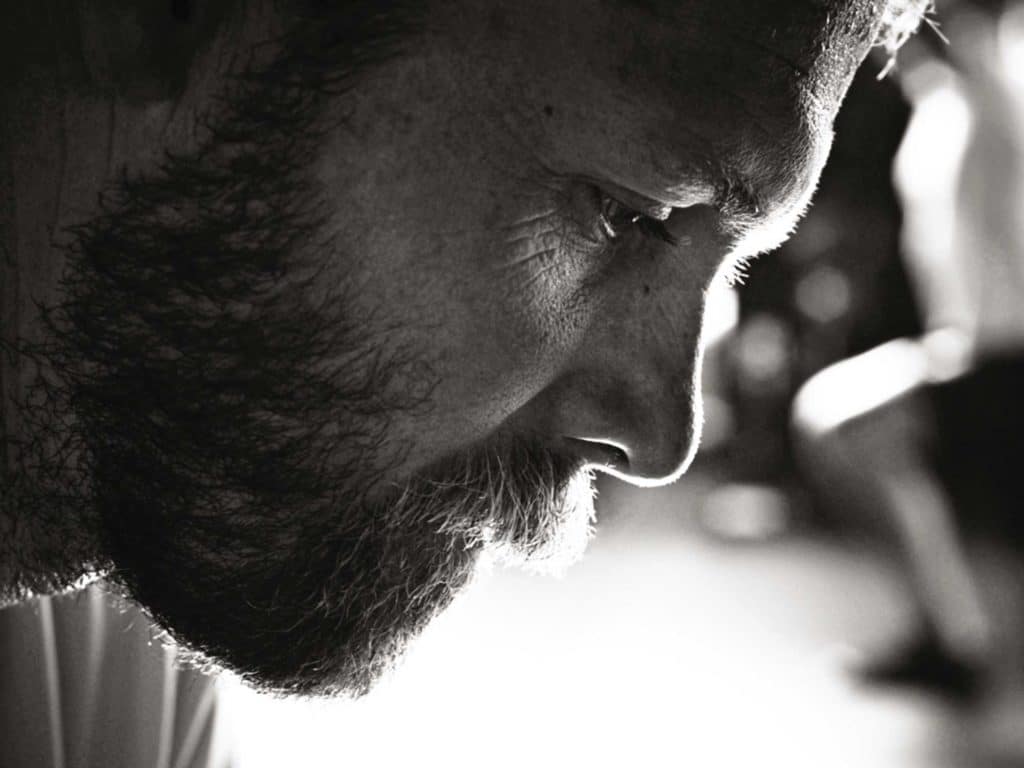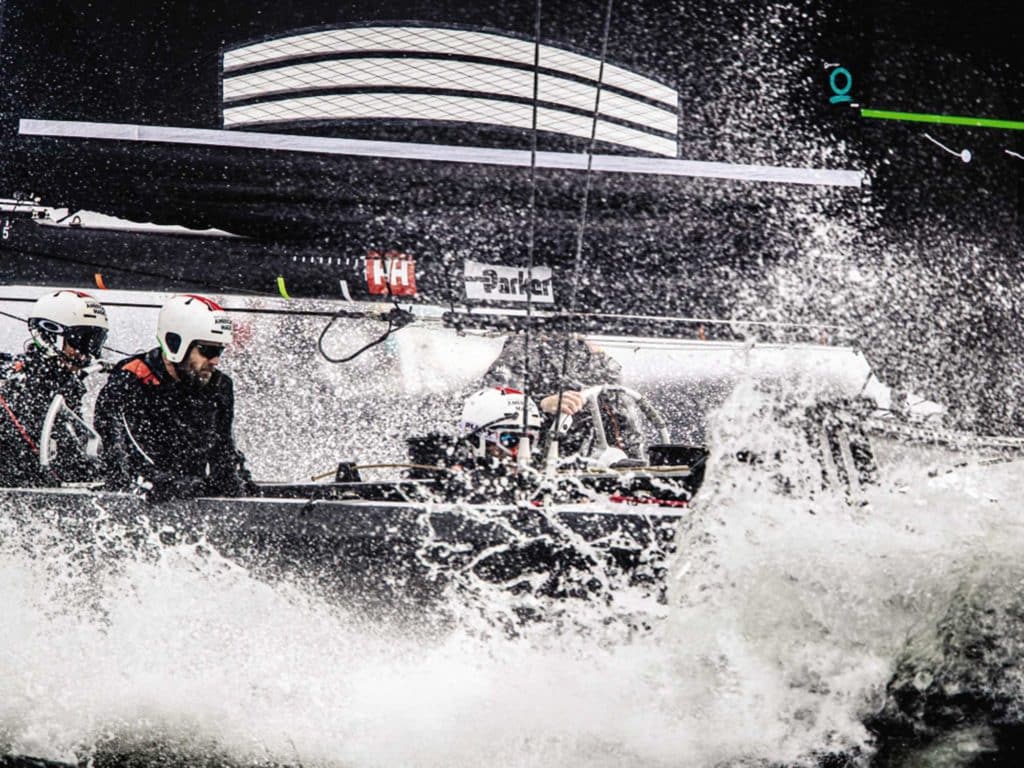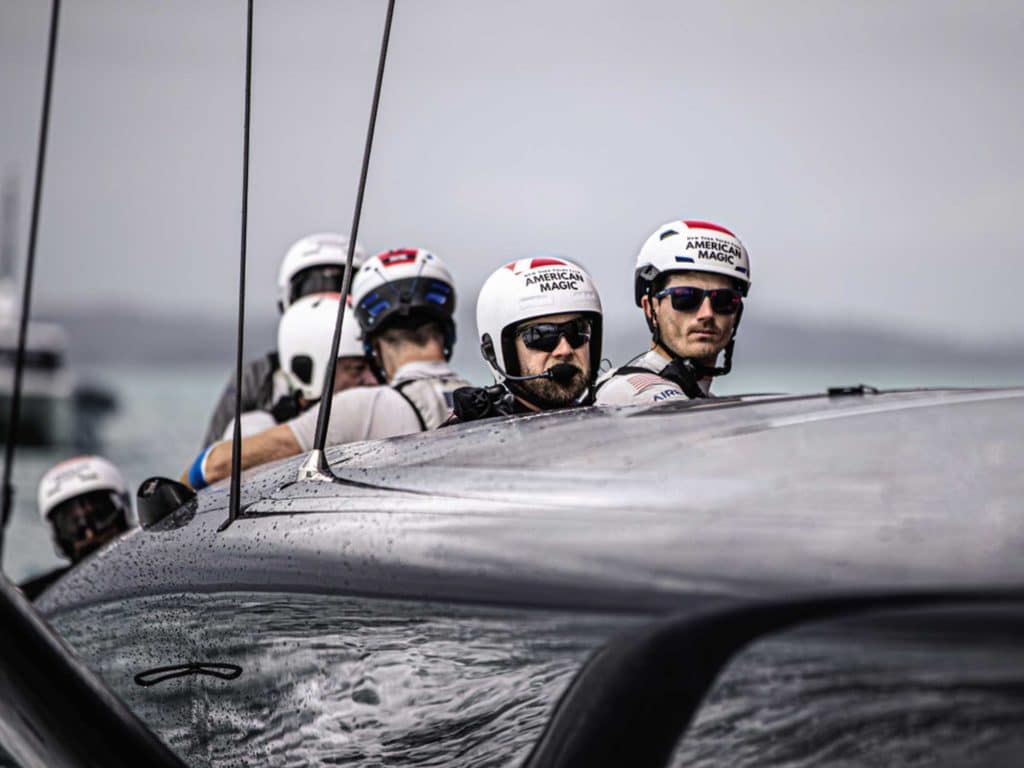
Andrew Campbell is huddled in the front of the starboard cockpit of American Magic’s Patriot as the dark-blue beast of a boat hits takeoff speed on New Zealand’s Hauraki Gulf. As the fantastical-looking Patriot rises up on its foils and skims over the tops of the waves, Campbell is flying the 75-foot monohull.
Yes, flying it. He is, after all, the flight controller. Welcome to the whiz-bang world of the 36th America’s Cup, which is jam-packed with both technology and a sense of the unknown.
Campbell has one of the most unique jobs in the America’s Cup, aboard perhaps the most complex class of boat on the planet, the AC75. Working in concert with helmsman Dean Barker and mainsail trimmer Paul Goodison, Campbell’s ability to fly Patriot will go a long way in determining whether American Magic can return the Auld Mug to the New York YC, which once enjoyed a 132-year winning streak in sailing’s marquee event.
“Yeah, essentially that’s my job,” 36-year-old Campbell says from Auckland. “It does take some coordination between the three guys: Paul Goodison trimming the mainsail, Dean driving, and then our jib trimmers. All the surfaces need to be all sorted out and in line, and the boatspeed has to be right for us to take off and get out of the water. But essentially it’s my job to decide when we’re going to take off and then to actually execute that. My actions make the boat take off.”
This America’s Cup will be nothing if not visual. The AC75 uses twin canting T-foils to help lift the hull completely out of the water in order to increase speed. In the normal sailing mode, the AC75 skims above the waves, riding only on the leeward foil and rudder, with the windward foil raised out of the water to reduce drag.
When the boat tacks or jibes, the arm that had been in the water is raised and the other one is lowered into the water, making it look like a giant nautical creature skittering above the water.
“My 5-year-old said, ‘Hey, that looks like the whale shark from the aquarium.’ I couldn’t disagree with him,” Campbell says. “The boats are very strange-looking. The fact that each of the teams has put out such a different version of how the hull is shaped and all of the wings are different and the foils, it’s just a super-exciting time for the sport.”
Both foils can be lowered in prestarts and through other maneuvers to provide extra lift and roll control, which also will be useful in rougher sea conditions.
“My job on board is to control the surfaces that are underwater: the two foils, their cant angles, which is the up and down motion of the arms, their flap positions,” says Campbell, an Olympian whose father, Bill, sailed in three America’s Cup campaigns. “The trailing edge of the foil moves like an aileron flap. We also have control of the rudder rake like the previous catamarans did. Between the three surfaces that are underwater, my job is to make sure we can run them in a way that keeps the boat up in the air.”

In a simpler sense, “the sensation is closer to an aircraft during takeoff,” Campbell says. “You rumble along building speed, adjusting and trimming to heel and boatspeed like any normal boat, but when you pass through the critical boatspeed and know you have enough lift, the equilibrium loads up and adds the third dimension, and up she goes.
“The Moth or smaller foiling platforms are more sensitive in terms of the boatspeed being much lower and top speed limited by the righting moment. That’s what separates these boats. They are big, powerful, and they carry momentum that the little boats don’t have. Definitely fun times.”
Terry Hutchinson, American Magic’s skipper and executive director, echoes that thought.
“It’s no more complicated than in the same manner you would fly an airplane,” Hutchinson says. “At a certain boatspeed, at a certain flap angle and at a certain rudder rake angle, the boat will come out of the water.
“I look at Andrew’s job, and I think it’s the hardest job on the boat,” Hutchinson adds. “He has the responsibility of making sure the boat is flying and performing in a manner the designers have designed the boat to sail. Andrew’s job takes an incredible amount of concentration. He has to be very disciplined in how he approaches his job because ultimately he’s carrying the responsibility of 10 other people, on top of himself, on the boat. And at the pace the boat is traveling and the environment we’re operating in, it’s not an easy job to do it. He’s completely earned unending respect from the entire team because of the level he’s operating at. It’s exciting to watch.”
Campbell says he doesn’t feel pressure because he’s been doing the job since day one of the program.
When American Magic began sailing its half-size test boat, the Mule, two years ago, it had a crew of only five. Campbell volunteered to be the flight controller.
“Having done the tactician role and driving out of the jibes and all that stuff with Oracle last time, I had a fair amount of experience doing it, and so I felt confident I could do it,” Campbell says. “And then all of a sudden, you look around the room, and no one else is that confident that they can do it, so it’s like, OK, here we are. You’re the tall poppy all of a sudden. That’s the one that’s easy to cut and say, ‘OK, you’re going to go out and do this.’ It didn’t fall into my lap, but it was something I was happy to pick up the responsibility for and run with it, and it’s turned into an interesting job. The learning curve is definitely steep. It’s been really interesting.
“I don’t come from an engineering background necessarily,’’ continues Campbell, the College Sailor of the Year in 2006. “My education is in diplomacy. I have a foreign-service degree from Georgetown. It’s not doing me a lot of good, yet. It helps me politically get through some of the meetings.”
The foil arms are one-design for all teams, but the American Magic’s flight system and software were developed in-house, with help from innovation partner Airbus.
“This is the third platform,” Campbell says. “We’ve gone through a lot of foils, and every foil is different and has its own little nuances, and they’ll bite you in the ass if you get it wrong every once in a while. It’s a fun game to play because it’s so dynamic.”
These are high-risk/high-reward boats that will sail faster than 50 knots. Nail the maneuvers, and the results can be sensational. Miss, and there will be trouble.
Patriot went for its first sail in mid-October. On its first jibe, the boat began to rise into the air and then nosedived into the pristine waters. Hutchinson said that was due to the rudder cavitating.
Trouble can be just an instant away.
“It’s easy to get out of sync, and when you do, they bite pretty hard, because it’s a lot of momentum and the boats are big,” Campbell says. “The 50-foot catamarans were kind of rough-and-tumble because they were smaller. It was a bit more like a sports-car feel. This is more like crashing a bus. If you come off wrong and you put the thing in, the momentum shift of the piece of equipment is staggering because it’s so much bigger.

“We’ve already been close a couple of times with this new platform. It’s an animal. If you’ve got it kind of calm and working and in range, you’re happy. It’s like a riding a horse out of the gate at a rodeo. If you don’t quite have it right, you’ve got to be able to recognize really quickly how to get it back in the range, otherwise you’re going to get bit.”
Not surprisingly, American Magic is tight-lipped about how Campbell controls the foils.
“He waves his magic wand, and up she comes,” Hutchinson jokes. “We’re just going to call it a control center.”
“I wish I could,” Campbell says when asked if he could describe the controls. “It’d be easy for you to see in a spy boat for sure what I’ve got going. It’s essentially a tool that allows me to pretty accurately put the foils in a position where I know where they are and where I don’t have to look at the controller in order to do it. It’s an electronic box. My actions are kind of directly put into the foils and the rudder. I have absolute control over the flap and the rams that are running the rudder rake. It’s all at my fingertips, and it’s just a question of being patient and calm enough to make sure I don’t overbake it.”
Campbell has an America’s Cup pedigree. His father, Bill, sailed with three campaigns from 1983-1995, an era that spanned the 12 Metres and the IACC sloops. He was a navigator on Courageous during the 1983 Defender Trials in Newport, Rhode Island, helmed the B boat and was sailing team manager with America’s Cup champion America3 in 1992, and served as tactician, navigator and B-boat helmsman with Nippon Challenge in 1995.
“From my standpoint, it’s so much fun having him so involved in sailing and so involved at this level. I can relate to how important it must be for him,” Bill Campbell says, from the family’s home in San Diego.
Getting used to his son’s job title has been another thing.
“No kidding. Who’d have thought, right? He keeps the boat in the air, up off the water,” he says, with a chuckle.
It’s been an interesting America’s Cup evolution for the Campbell family, from the relatively plodding sloops Bill sailed on to the flying machine Andrew helps sail.
Bill says he’s never sailed on a foiling boat. “I don’t have that feeling for what it’s like,” he says. “Andrew has told us it’s like all of a sudden you get up off the water and the boat just takes off, and it’s incredible acceleration up to the top speed it gets to.”
Twelve years ago, Andrew Campbell was sailing a Laser in the Beijing Olympics. Today, he’s at the controls of a boat that is like nothing any of the crew has ever sailed.
“It’s a completely different world, completely different sensation,” Campbell says. “You have to be so focused on what’s happening. It so quickly gets out of balance that you can’t afford to lose track of where you are.
“I come in off the water not having done any physical exertion, basically, and I’m exhausted because I’m trying to be so focused on keeping the platform in such a narrow groove all day,” he says. “That, at the end of the day, is kind of the beauty of our sport. You have to be completely present and completely focused on what’s happening in that moment. Otherwise, things go wrong. We’re really lucky to be able to do that and not be distracted by other stuff for a few hours every day.”









